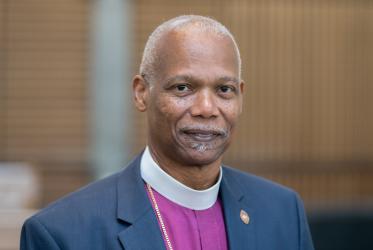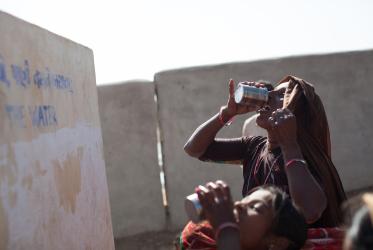Text: 2 Kings 5:9-14
Reflection
When Naaman, the commander of the army, suffering from leprosy went to meet Prophet Elisha in anticipation of being cured of his leprosy, Elisha simply asked him to wash in the river Jordan, seven times. Naaman quite obviously was upset and he almost did not obey Elisha’s instruction, as the “cure” from his disease was such a simple remedy. But when he did obey, he was miraculously healed from his leprosy.
I am writing this reflection when the world is under the grip of the COVID-19 (coronavirus). Our television screens, newspapers and social media are screaming loudly 24 x 7 about the global pandemic that has brought the world to a standstill. In about 3 months, first detected in Wuhan in China, today it has reached over 180 countries with over 265,000 cases of infection and over 11,000 deaths. While China has reported zero new cases for the first time, Europe – particularly, Italy, France, Germany, Switzerland and the USA are yet to see its peak. The Economist Intelligence Unit predicts the virus could infect at least half of world’s population with an unthinkable number of deaths if strictest measures are not put in place. Countries have been locked down for weeks and months and people, including myself, are advised to remain homebound, isolated to break spreading of the virus. Currently there is no cure for this pandemic and no sight of a vaccine in the near future. But the most important and common advice is “hand-washing.” It sounds like an oxymoron when the most contagious and probably lethal virus witnessed in the 21st century has a very simple remedy to remain safe is by washing our hands with water and soap. I was reminded of Naaman’s story. However, we may be surprised to note that it is not possible for everyone in the world to wash their hands several times a day to avoid infection, simply because they do not have adequate access to safe and clean water for drinking, let alone for hand-washing. To this end, to encourage the children in developing countries, 15 October is recognised as global Hand Washing Day. Can you imagine how challenging hand-washing is without a tap at home or school? But that is the reality for millions of children around the world.
Now coming to the theme of the reflection "Water and Climate Change.” This theme is derived from the theme of World Water Day, which is being observed on 22 March. Climate change is one of the most pressing issues of our time. We human beings have plundered the earth’s resources for our greed and comfort. As a result, climate change is fast approaching a "tipping point" of an irreversible change towards death and destruction of our planet. The impact of climate change can be felt with rising maximum temperatures, rising minimum temperatures, rising sea levels, higher ocean temperatures, erratic rainfall leading to floods and drought, shrinking glaciers, and thawing permafrost. All these happen cyclically, one triggering the other. The indirect consequences of climate change, which directly affect us humans and our environment, include: an increase in hunger and water crises, and more health issues, especially in developing countries.
A policy brief on climate change and water produced by UN Water says, “The global climate change crisis is inextricably linked to water. Climate change is increasing variability in the water cycle, thus inducing extreme weather events, reducing the predictability of water availability, decreasing water quality and threatening sustainable development, biodiversity and enjoyment of the human rights to safe drinking water and sanitation worldwide.”[1] There are significant co-benefits to managing climate and water in a more coordinated and sustainable manner. In 2015 three major global commitments were adopted:
1) Sustainable Development Goals (SDGs)– 17 global goals aim to end all forms of poverty and hunger, fight inequalities and tackle climate change, clean water for all
2) United Nations Framework Convention on Climate Change (UNFCCC) Paris Agreement emphasising the need to limit the rise of global average temperature to well below 2°C above pre-industrial levels
3) The Sendai Framework for Disaster Risk Reduction 2015–2030
There was one thing common in all three global commitment mechanisms. That's water! Given water’s inherent centrality to achieving these goals, it can play a connector role among them, reinforcing and strengthening each country’s commitments to mitigating and adapting to climate change, reducing disaster risks, ending poverty and inequality, and “leaving no one behind.”
An estimated 3.6 billion people worldwide now live in areas that are potentially water-scarce at least one month per year. According to The United Nations World Water Development Report[2], that will increase to 4.8–5.7 billion people by 2050, thus creating unprecedented competition among water users and across political boundaries.[3]
Meeting the Paris Agreement 1.5 °C above pre-industrial levels, compared to 2°C, can have huge implications on water resources as it may increase the water stress induced by climate change by up to 50 percent. 70% of freshwater usage is for agriculture and food production. A 50% increase in water stress means severe food shortage, unless we change our food habit to a primarily vegetarian diet.
The Pacific context:
While the rest of the world is seeing the impact of climate change through excessive water (floods) or the lack of water (drought), the Pacific region is witnessing far more shocking experiences. Their lands are disappearing into the rising sea levels. On a recent visit to Fiji in January 2020, I was part of a delegation of the World Council of Churches Pilgrimage of Justice and Peace. We went to Vunidogoloa - a relocated village, the first among 400 villages that are planned to be relocated due to the impact of climate change through rising sea levels. People lost their land and the memories of generations along with it.
The Pacific islands are surrounded by waters. However, the availability of freshwater continues to remain a challenge with the growing saltwater incursion into the freshwater sources. Many of the freshwater streams and creeks are getting affected by climate change. The Rime of the Ancient Mariner by the English poet Samuel Taylor rightly puts it “Water, water everywhere, nor any drop to drink.” The rest are being bottled by the bottled water industries such as the Fiji Waters, an American corporation.
Questions for discussion
- As a result of COVID-19, the earth's atmosphere has significantly improved with less greenhouse gas emission. Birds, fishes and animals are spotted in the cities. Do you think nature is "reclaiming" its space through COVID-19?
- Why and how does water connect the SDGs, the Paris Agreement and Sendai Framework?
Actions
- You can organise a small workshop to commemorate World Water Day (22 March)/ Earth Day (22 April) in your church. If physical gathering is not possible due to COVID -19 restrictions, a virtual webinar is also possible through a Zoom call/ Skype etc.
- Promote hand-washing hygiene in schools / Sunday schools. Do a demo of hand-washing.
Resources
- Observe World Water Day on 22 March or any other day closer to it
- October 15: Global handwashing day
[1]https://www.unwater.org/app/uploads/2019/10/UN_Water_PolicyBrief_Climat…
[2] The United Nations World Water Development Report 2018: Nature-based Solutions for Water (United Nations Educational, Scientific and Cultural Organization, Paris, 2018).
[3]https://www.unwater.org/app/uploads/2019/10/UN_Water_PolicyBrief_Climat…




